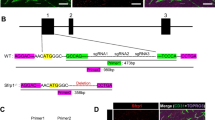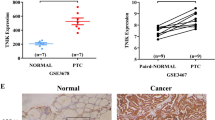Abstract
Currently, the primary therapeutic strategy for most growth hormone-producing pituitary adenomas (GHPA) is surgery. Due to the invasiveness of GHPA, high recurrence has limited the benefit of complete adenoma removal surgery. Epidermal growth factor-like domain 7 (EGFL7) is a secreted factor implicated in tumor angiogenesis, growth, invasiveness and metastasis in GHPA. Herein, we observed that the expression level of EGFL7 and p-EGFR in invasive GHPA was much higher than that of non-invasive GHPA. The overexpression of EGFL7 was positively correlated with activation of EGFR (p-EGFR). Noticeably, EGFL7 knockdown significantly inhibited activation of EGFR signaling cascades, including p-ERGR, p-AKT and p-ERK. Further studies showed that EGFL7 knockdown or pharmacological inhibition of EGFR-pathway, using EGFR inhibitor Tyrphostin AG-1478, significantly suppressed migration and invasion of GH3 and GT1-1 cells. In summary, our findings suggest that EGFL7 is a key factor for regulation of EGFR signaling pathway and plays an important role in migration and invasion of invasive GHPA.
Similar content being viewed by others
References
Alexandru, O., Purcaru, S.O., Tataranu, L.G., Lucan, L., Castro, J., Folcuţi, C., Artene, S.A., Tuţă, C., and Dricu, A. (2018). The influence of EGFR inactivation on the radiation response in high grade glioma. Int J Mol Sci 19, 229.
Avraham, R., and Yarden, Y. (2011). Feedback regulation of EGFR signalling: decision making by early and delayed loops. Nat Rev Mol Cell Biol 12, 104–117.
Bush, N.A.O., and Butowski, N. (2017). The effect of molecular diagnostics on the treatment of glioma. Curr Oncol Rep 19, 26.
Campagnolo, L., Leahy, A., Chitnis, S., Koschnick, S., Fitch, M.J., Fallon, J.T., Loskutoff, D., Taubman, M.B., and Stuhlmann, H. (2005). EGFL7 is a chemoattractant for endothelial cells and is up-regulated in angiogenesis and arterial injury. Am J Pathol 167, 275–284.
Chiasson-MacKenzie, C., and McClatchey, A.I. (2018). EGFR-induced cytoskeletal changes drive complex cell behaviors: the tip of the iceberg. Sci Signal 11, eaas9473.
Dhandapani, S., Singh, H., Negm, H.M., Cohen, S., Anand, V.K., and Schwartz, T.H. (2016). Cavernous sinus invasion in pituitary adenomas: systematic review and pooled data meta-analysis of radiologic criteria and comparison of endoscopic and microscopic surgery. World Neurosurgery 96, 36–46.
Díaz, R., Silva, J., García, J.M., Lorenzo, Y., García, V., Peña, C., Rodríguez, R., Muñoz, C., García, F., Bonilla, F., et al. (2008). Deregulated expression of miR-106a predicts survival in human colon cancer patients. Genes Chromosom Cancer 47, 794–802.
Feng, K., Guo, Y., Dai, H., Wang, Y., Li, X., Jia, H., and Han, W. (2016). Chimeric antigen receptor-modified T cells for the immunotherapy of patients with EGFR-expressing advanced relapsed/refractory non-small cell lung cancer. Sci China Life Sci 59, 468–479.
Geethadevi, A., Parashar, D., Bishop, E., Pradeep, S., and Chaluvally-Raghavan, P. (2017). ERBB signaling in CTCs of ovarian cancer and glioblastoma. Genes Cancer 8, 746–751.
Huang, C., Li, X., Zhou, Y., Luo, Y., Li, C., and Yuan, X. (2010). Expression and clinical significance of EGFL7 in malignant glioma. J Cancer Res Clin Oncol 136, 1737–1743.
Huang, C., Yuan, X., Li, Z., Tian, Z., Zhan, X., Zhang, J., and Li, X. (2014). VE-statin/Egfl7 siRNA inhibits angiogenesis in malignant glioma in vitro. Int J Clin Exp Pathol 7, 1077–1084.
Kwatra, M.M. (2017). A rational approach to target the epidermal growth factor receptor in glioblastoma. Curr Cancer Drug Targets 17, 290–296.
Liu, Q., Wang, J., Yang, H., Gao, H., Li, C., Lan, X., and Zhang, Y. (2018). Attenuation of EGFL7 expression inhibits growth hormone–producing pituitary adenomas growth and invasion. Hum Gene Ther doi: 10.1089/hum.2017.200.
Lopes, M.B.S. (2017). The 2017 World Health Organization classification of tumors of the pituitary gland: a summary. Acta Neuropathol 134, 521–535.
Luo, W., Shao, C., Li, N., Zhang, F., Guo, S., Duan, Z., Zheng, Q., and He, H. (2015). Expression of epidermal growth factor-like domain 7 correlates with clinicopathological features of osteosarcoma. Am J Transl Res 7, 1236–1245.
Mete, O., and Lopes, M.B. (2017). Overview of the 2017 WHO classification of pituitary tumors. Endocr Pathol 28, 228–243.
Nagata, Y., Inoshita, N., Fukuhara, N., Yamaguchi-Okada, M., Nishioka, H., Iwata, T., Yoshimoto, K., and Yamada, S. (2018). Growth hormoneproducing pituitary adenomas in childhood and young adulthood: clinical features and outcomes. Pituitary 21, 1–9.
Normanno, N., Bianco, C., Strizzi, L., Mancino, M., Maiello, M., Luca, A., Caponigro, F., and Salomon, D. (2005). The ErbB receptors and their ligands in cancer: an overview. Curr Drug Targets 6, 243–257.
Normanno, N., De Luca, A., Bianco, C., Strizzi, L., Mancino, M., Maiello, M.R., Carotenuto, A., De Feo, G., Caponigro, F., and Salomon, D.S. (2006). Epidermal growth factor receptor (EGFR) signaling in cancer. Gene 366, 2–16.
Ntali, G., and Wass, J.A. (2018). Epidemiology, clinical presentation and diagnosis of non-functioning pituitary adenomas. Pituitary 21, 111–118.
Parker, L.H., Schmidt, M., Jin, S.W., Gray, A.M., Beis, D., Pham, T., Frantz, G., Palmieri, S., Hillan, K., Stainier, D.Y.R., et al. (2004). The endothelial-cell-derived secreted factor Egfl7 regulates vascular tube formation. Nature 428, 754–758.
Philippin-Lauridant, G., Baranzelli, M.C., Samson, C., Fournier, C., Pinte, S., Mattot, V., Bonneterre, J., and Soncin, F. (2013). Expression of Egfl7 correlates with low-grade invasive lesions in human breast cancer. Int J Oncol 42, 1367–1375.
Shi, Q., and Chen, Y.G. (2017). Interplay between TGF-β signaling and receptor tyrosine kinases in tumor development. Sci China Life Sci 60, 1133–1141.
Soncin, F., Mattot, V., Lionneton, F., Spruyt, N., Lepretre, F., Begue, A., and Stehelin, D. (2003). VE-statin, an endothelial repressor of smooth muscle cell migration. EMBO J 22, 5700–5711.
Sun, L., Yu, S., Xu, H., Zheng, Y., Lin, J., Wu, M., Wang, J., Wang, A., Lan, Q., Furnari, F., et al. (2018). FHL2 interacts with EGFR to promote glioblastoma growth. Oncogene 37, 1386–1398.
Tampourlou, M., Fountas, A., Ntali, G., and Karavitaki, N. (2018). Mortality in patients with non-functioning pituitary adenoma. Pituitary 21, 203–207.
Wang, F.Y.F., Kang, C.S., Wang-Gou, S.Y., Huang, C.H., Feng, C.Y., and Li, X.J. (2017a). EGFL7 is an intercellular EGFR signal messenger that plays an oncogenic role in glioma. Cancer Lett 384, 9–18.
Wang, J., Liu, Q., Gao, H., Wan, D., Li, C., Li, Z., and Zhang, Y. (2017b). EGFL7 participates in regulating biological behavior of growth hormone-secreting pituitary adenomas via Notch2/DLL3 signaling pathway. Tumour Biol 39, 1–11.
Wang, J., Zhang, Z., Li, R., Sun, W., Chen, J., Zhang, H., Shu, K., and Lei, T. (2017c). Triptolide inhibits pituitary adenoma cell viability, migration and invasion via ADAM12/EGFR signaling pathway. Life Sci 194, 150–156.
Wang, Y., Sun, H., Xiao, Z., Zhang, D., Bao, X., and Wei, N. (2017d). XWL-1-48 exerts antitumor activity via targeting topoisomerase II and enhancing degradation of Mdm2 in human hepatocellular carcinoma. Sci Rep 7, 9989.
Worthylake, R., Opresko, L.K., and Wiley, H.S. (1999). ErbB-2 amplification inhibits down-regulation and induces constitutive activation of both ErbB-2 and epidermal growth factor receptors. J Biol Chem 274, 8865–8874.
Wu, F., Yang, L.Y., Li, Y.F., Ou, D.P., Chen, D.P., and Fan, C. (2009). Novel role for epidermal growth factor-like domain 7 in metastasis of human hepatocellular carcinoma. Hepatology 50, 1839–1850.
Zhu, W., and Qin, L. (2017). GOLM1-regulated EGFR/RTK recycling is a novel target for combating HCC metastasis. Sci China Life Sci 60, 98–101.
Zoli, M., Milanese, L., Bonfatti, R., Sturiale, C., Pasquini, E., Frank, G., and Mazzatenta, D. (2016). Cavernous sinus invasion by pituitary adenomas: role of endoscopic endonasal surgery. J Neurosurg Sci 60, 485–494.
Acknowledgements
This work was supported by the National Natural Science Foundation of China (81502154), Research Special Fund For Public Welfare Industry of Health of China (201402008) and National High Technology Research and Development Program of China (2015AA020504).
Author information
Authors and Affiliations
Corresponding author
Electronic supplementary material
Rights and permissions
About this article
Cite this article
Liu, Q., Zhang, J., Gao, H. et al. Role of EGFL7/EGFR-signaling pathway in migration and invasion of growth hormone-producing pituitary adenomas. Sci. China Life Sci. 61, 893–901 (2018). https://doi.org/10.1007/s11427-018-9320-4
Received:
Accepted:
Published:
Issue Date:
DOI: https://doi.org/10.1007/s11427-018-9320-4




